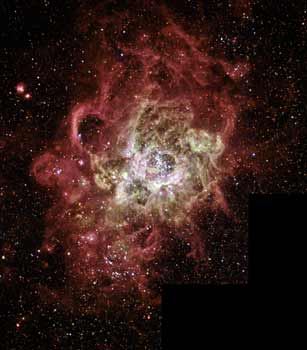An area that serves as a stellar incubator, including over 200 bright blue stars within a cloud of glowing gas 1,300 light-years wide,

The colorful nebula, known as NGC 604, is one of the star-making craters in a nearby galaxy. NGC 604 is similar to the familiar star birth regions of our Milky Way, such as the Orion Nebula, but is much larger and contains many more recently formed stars. This is according to photographs taken by the Hubble Space Telescope and compiled by scientists at the Space Telescope Science Center.
An area used as an incubator, includes over 200 bright blue stars within a cloud of glowing gas 1,300 light-years across, nearly a thousand times the size of the Orion Nebula. By comparison, the Orion Nebula has a total of four bright stars at its center. The bright stars of NGC 604 are much younger by astronomical standards, barely 3 million years old.
Most of the bright and hot stars form in a loose cluster located around the center of the nebula. Stellar wind from these hot blue stars, along with shock and particles from exploding supernovae, are responsible for creating a hole at the center. The most massive stars in NGC 604 reach 120 times the mass of the Sun, and their surface temperature reaches 40 thousand degrees Kelvin. Ultraviolet radiation streams out from these stars, causing the gas in the nebula to glow.
NGC 604 resides in the spiral arm of the nearby galaxy M33, which lies 2.7 million light-years away in the direction of the Triangular Cluster. M33 is a member of our local group of galaxies, which includes the Milky Way and Andromeda, and can easily be seen in binoculars. NGC 604 itself is viewable with a small telescope, and was first recognized by the British astronomer William Herschel in 1784. In our group, only the Tarantula Nebula in the Large Magellanic Cloud is larger than NGC 604 in the number of young stars, although the size of the Tarantula is slightly smaller than that of NGC 604.
NGC 604 provides Hubble-observed astronomers with a close-up example of a giant star-forming region. Such regions are scaled down to distant Starbursts galaxies known as vast star factories. It is commonly assumed that such starbursts were common in the early universe, when the rate of star formation was much higher. Supernovae that exploded in these galaxies created the first heavy elements, and which until then the universe consisted mainly of hydrogen and helium.
This image of NGC 604 was assembled from observations taken by Hubble's Wide Field Camera #2 in 1994, 1995, and 2001. The scientists used color filters to isolate the light emitted from the hydrogen, oxygen, nitrogen and sulfur atoms in the nebula as well as the ultraviolet, visible and infrared from the stars in and around NGC 604 in the spiral arm of M33. The Hubble Heritage team and the Space Telescope Science Institute scientists combined the images from the various filters to create this colorful image.
